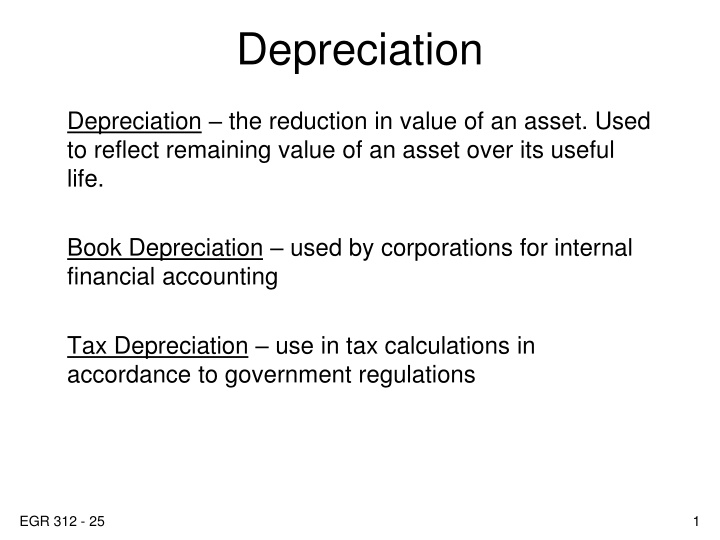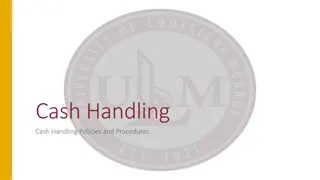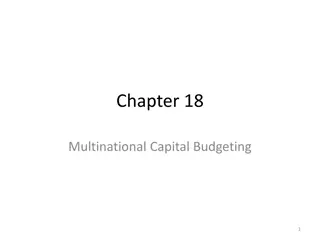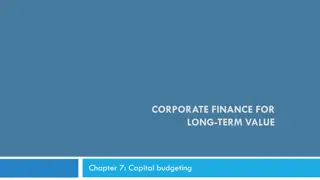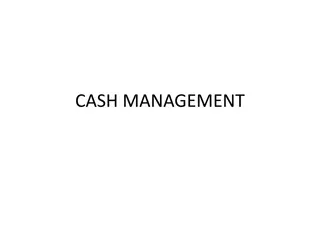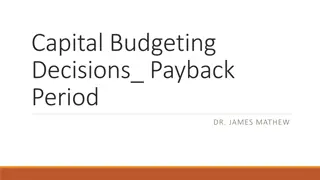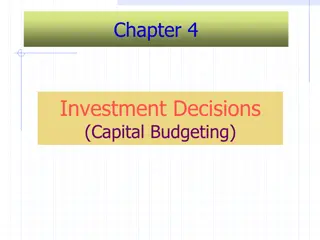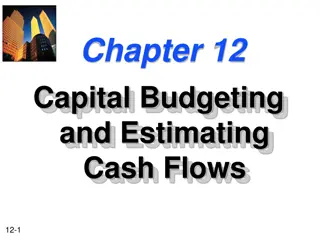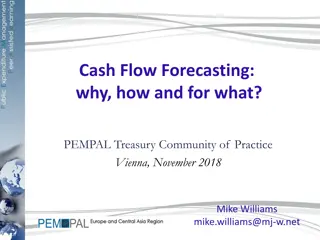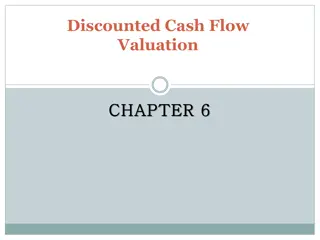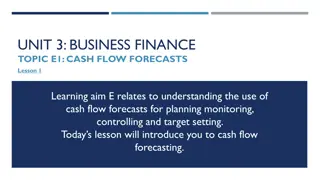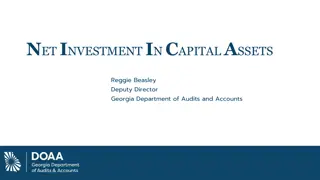Making Capital Investment Decisions: Understanding Relevant Cash Flows
A detailed discussion on incremental cash flows, stand-alone principle, analyzing project feasibility, and common types of cash flows in capital budgeting decisions. Learn how to differentiate after-tax cash flows, accounting profit, and net income. Explore the significance of pro forma statements and cash flow computation methods like OCF and CFFA.
Download Presentation

Please find below an Image/Link to download the presentation.
The content on the website is provided AS IS for your information and personal use only. It may not be sold, licensed, or shared on other websites without obtaining consent from the author.If you encounter any issues during the download, it is possible that the publisher has removed the file from their server.
You are allowed to download the files provided on this website for personal or commercial use, subject to the condition that they are used lawfully. All files are the property of their respective owners.
The content on the website is provided AS IS for your information and personal use only. It may not be sold, licensed, or shared on other websites without obtaining consent from the author.
E N D
Presentation Transcript
Depreciation Depreciation the reduction in value of an asset. Used to reflect remaining value of an asset over its useful life. Book Depreciation used by corporations for internal financial accounting Tax Depreciation use in tax calculations in accordance to government regulations EGR 312 - 25 1
Why is depreciation important? Depreciation can lower your taxes: taxes = (income deductions)*tax rate where one of the primary deductions is depreciation. In other words, the use of depreciation can make you money by reducing the amount of taxes you pay. EGR 312 - 25 2
Definitions First Cost cost of purchasing and installing an asset (on real-estate, the value of land is excluded) Book Value the remaining, undepreciated capital of an asset which is on the corporation s books; the first cost minus the sum of all deprecation taken Recovery Period depreciable life of the asset in years Market Value estimate of the value of an asset if sold on the open market, not necessarily the same as the book value. EGR 312 - 25 3
Definitions Depreciation Rate the fraction of the First Cost removed by depreciation each year. Personal Property allowed for depreciation, includes items such as manufacturing equipment, vehicles, computers, etc. Real Property also allowed for depreciation, includes office buildings, warehouses, manufacturing facilities, etc note, land is not depreciated. Half-year convention assumes assets are placed in service in midyear. EGR 312 - 25 4
Straight Line (SL) Depreciation Book value depreciates linearly with time. In other words, depreciation is removed in equal amounts each year. B S = = ( ) Dt B S d n Where t= year (1,2, n) Dt= annual depreciation charge B = first cost S = estimated salvage value n = recovery period d = depreciation rate = 1/n EGR 312 - 25 5
SL Depreciation Book value (SL): = BV B tD t t Depreciation rate is constant: 1 = = d d t n EGR 312 - 25 6
SL Depreciation Example: A $20,000 vehicle is to be depreciated over 7 years using SL depreciation. Year 0 1 2 3 4 5 6 7 Book Value $20,000 $17,143 $14,286 $11,429 $8,571 $5,714 $2,857 $0 Dt Straight Line Depreciation $25,000 $2,857 $2,857 $2,857 $2,857 $2,857 $2,857 $2,857 $20,000 Book Value $15,000 $10,000 $5,000 $0 0 2 4 6 8 Year EGR 312 - 25 7
Depreciation Straight Line (SL) Depreciation Example: What would the yearly depreciation and depreciation rate be if the $20,000 vehicle is expected to have a salvage value of $6,000? Dt = _____________ d = ______________ EGR 312 - 25 8
Declining Balance (DB) Depreciation Book value depreciates by a fixed percentage of the book value, not a fixed amount. = t D dBV 1 t Where t= year (1,2, n) BVt-1= book value in year t - 1 Dt = depreciation amount in year t d = depreciation rate EGR 312 - 25 9
DB Depreciation Book value (DB): = = 1 ( t ) BV B d t BV BV D 1 t t t EGR 312 - 25 10
DB Depreciation Example: A $20,000 vehicle is to be depreciated over 7 years using DB depreciation with a depreciation rate of 0.25. Year 0 1 2 3 4 5 6 7 Book Value $20,000 $15,000 $11,250 $8,438 $6,328 $4,746 $3,560 $2,670 Dt Declining Balance Depreciation $25,000 $5,000 $3,750 $2,813 $2,109 $1,582 $1,187 $890 $20,000 Book Value $15,000 $10,000 $5,000 $0 0 2 4 6 8 Year EGR 312 - 25 11
Double Declining Balance (DDB) Depreciation The maximum annual depreciation rate for DB method is: dmax = 2/n In this case, the method is called double declining balance (DDB) EGR 312 - 25 12
Modified Accelerated Cost Recovery System (MACRS) MACRS is the US government accepted depreciation schedule for tax purposes. MACRS combines facets of DDB and SL methods. Assets are grouped into categories based on recovery periods of 3, 5, 7, 10, 15, 20, 27.5, and 39 years. See table 16-4, pg. 426 for asset groupings. Examples: landscaping around the UC rental house tooling for new line of refrigerators EGR 312 - 25 13
MACRS To determine the amount of deprecation each year, use the following depreciation rate table (table 16-2, pg. 423.) Depreciation Rate (%) for Each MACRS Recovery Period in Years Year 1 2 3 4 5 6 7 8 9 10 11 12 13 14 15 16 17-20 21 n=3 33.33 44.45 14.81 7.41 n=5 20 32 19.2 11.52 11.52 5.76 n=7 14.29 24.49 17.49 12.49 8.93 8.92 8.93 4.46 n=10 10 18 14.4 11.52 9.22 7.37 6.55 6.55 6.55 6.55 3.28 n=15 5 9.5 8.55 7.7 6.93 6.23 5.9 5.9 5.91 5.9 5.91 5.9 5.91 5.9 5.91 2.95 n=20 3.75 7.22 6.68 6.18 5.71 5.29 4.89 4.52 4.46 4.46 4.46 4.46 4.46 4.46 4.46 4.46 4.46 2.23 Note: see the top of pg. 424 for instructions regarding real property (39 year life). EGR 312 - 25 14
MACRS Example: A $20,000 vehicle is to be depreciated for tax purposes. MACRS Depreciation Year Book Value 20000 16000 dt Dt 0 1 2 3 4 5 6 25000 0.2 0.32 0.192 0.1152 0.1152 0.0576 4000 6400 3840 2304 2304 1152 20000 Book Value 9600 5760 3456 1152 15000 10000 5000 0 0 1 2 3 4 5 6 7 0 Year EGR 312 - 25 15
Depletion Methods Depletion: book (noncash) method to represent decreasing value of natural resources. Cost depletion (CD): Based on the level of activity required to remove a natural resource Percentage depletion (PD): Based on gross income (GI) from resource EGR 312 - 25 16
Calculations Cost Depletion: Multiply factor CDt by amount of resource removed Where: CDt = first cost / resource capacity Total depletion can not exceed first cost of the resource Percentage Depletion: Multiply GI by standardized rate (%) (from table on pg. 427) Annual depletion can not exceed 50% of company s taxable income (TI) EGR 312 - 25 17
Example A mine purchased for $3.5 million has a total expected yield of one million ounces of silver. Determine the depletion charge in year 4 when 300,000 ounces are mined and sold for $30 per ounce using (a) cost depletion, and (b) percentage depletion. (c) Which is larger for year 4? (a) Factor, CD4= ______________________________ CDA4= __________________________ (b) Percentage depletion rate for silver mines is _____ PDA4= __________________________ (c) Claim percentage depletion amount, provided it is 50% of TI. EGR 312 - 25 18
